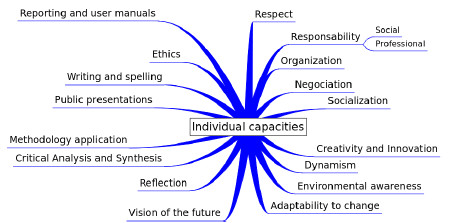Servicios Personalizados
Revista
Articulo
Links relacionados
Compartir
CLEI Electronic Journal
versión On-line ISSN 0717-5000
CLEIej vol.17 no.3 Montevideo dic. 2014
A Detailed Study of the Computer Science Degree at the Central University of Venezuela:
Towards a New Curriculum Design
Maria E. Villapol, Zenaida Castillo, Alecia E. Acosta, Marco Gómez, Adrian Bottini, Rhadamés Carmona, Harun Juhasz, Carlos Acosta
maria.villapol@ciens.ucv.ve, zenaida.castillo@ciens.ucv.ve , eleonora.acosta@ciens.ucv.ve, marcogonzalo@gmail.com, adrian.bottini@ciens.ucv.ve, rhadames.carmona@ciens.ucv.ve, harunjuhasz@gmail.com, carlos.acosta@ciens.ucv.ve,
Escuela de Computación
Universidad Central de Venezuela
Caracas, Venezuela
Abstract— The Central University of Venezuela, as part of its efforts for adapting its academic offer to national and international needs, is conducting a project to review, evaluate and modify the Computer Science curriculum, in order to form the professional required by the country. In this paper we present the results of the first stage of the project: an assessment of the Computer Science curriculum based on the use of various data collection instruments used to determine the professor, student and graduates perception of the program as well as deficiencies and potential of our graduates, according to the companies and organizations that hire them. The results show that there exist a gap between the perception of our professors about the program and the opinion of the employers. We also present information about student performance during the last decade, which is an input to the next stage of the program redesign.
Resumen-- La Universidad Central de Venezuela, como parte de sus esfuerzos para la adaptación de su oferta académica a las necesidades nacionales e internacionales, está llevando a cabo un proyecto para revisar, evaluar y modificar el Plan de Estudios de la cerrera en Computación, con el fin de formar el profesional requerido por el país. En este trabajo se presentan los resultados de la primera etapa del proyecto: evaluación del Plan de Estudios de Computación en base a la utilización de diversos instrumentos de recolección de datos que se utilizan para determinar la percepción del profesor, los estudiantes y egresados de dicho plan, así como también las deficiencias y potencialidades de nuestros egresados, de acuerdo con las empresas y entidades que los contratan. Los resultados muestran que existe una brecha entre la percepción de nuestros profesores sobre el Plan de Estudio y la opinión de los empleadores. También se presenta información sobre el desempeño del estudiante durante la última década, que es valioso insumo para la siguiente etapa del rediseño del programa.
Palabras clave: Universidad Central de Venezuela , Plan de Estudio de la carrera en Computación, evaluación.
Keywords— Central University of Venezuela, Computer Science curriculum, assessment.
Received 2013-11-15, Revised 2014-02-20 Accepted 2014-02-20
1. Introduction
The rapid development of the hardware and software technologies results in the need of a constant revision of the Computer Science curricula. The Central University of Venezuela (Universidad Central de Venezuela, UCV), in an effort to adapt its academic offer to both international and national education demands is reviewing, evaluating and updating the curriculum of the Computer Science degree in the Computer Science School. The aim of the university is to prepare the students for the computing technology demands of the country.
To achieve this objective, we followed a methodology that involves the following stages:
Initial stage: it is aimed to establish the needs of the curriculum redesign and the basis required for the people who will implement the changes. It is divided into:
Increasing awareness in curriculum change
Formation of working teams
Detection of updating needs
Development: it involves the following activities:
Establishment of the basis of the curriculum
Definition of competency profiles
Revision and redesign of the curriculum
Revision and redesign of the courses
We study the Computer Science curriculum in order to know whether we need to update it or not, which is a compulsory activity of the initial stage. This document describes the results obtained in the study, which includes the use of some tools: surveys to students and graduates, interviews to professors, and brainstorming sessions with groups of professors. We also met representatives of public organizations and private companies. Moreover, we reviewed the performance of the students during a determined period of time. Finally we measured the opinion of the graduates from the Computer Science School at UCV about the curriculum and how it may be improved. The document begins with a detailed description of current Computer Science curriculum, then presents the method for the collection of information and finally shows the results of the study.
2. Background
A group of professors working in Numerical Calculus in the Mathematical School at the Faculty of Science developed the first Computer Science curriculum [1] during the 60s. Later, the new technologies and trends in software development drove the design of a new curriculum, which was released in 1985. At the end of 1990, the Curriculum Committee evaluated the technology changes in the country and around the world and developed the 2000 Computer Science curriculum. Several minor changes were conducted between 2004 and 2005. The current version includes the following components: (a) Basic formation, (b) Instrumental formation, (c) Professional formation, (d) Professional internships, and (e) Complementary formation.
Table 1 shows the distribution of these components according to the number and kind of courses: compulsory, elective and optional. We define the types of courses as follows:
Compulsory course: it must be completed by each student.
Elective course: a course that students can select from among several courses.
Optional course: it belongs to a set of courses. A student must complete at least two.
The students must complete courses which belong to the basic formation and instrumental formation during the first five semesters of the career. These components include the compulsory courses that a student must complete in order to obtain the basic skills.
The professional formation supports the Professional Options including the courses that a student must take in order to obtain the skills required in a specific area of computing (e.g. Software Engineering). To complete a Professional Option, a student must pass three elective courses of the option, finish successfully the Seminar course and finally develop an Undergraduate Research Project (thesis) in the area.
Table 1 Curriculum components (2000) [1]

The School Board establishes the Professional Options, which are managed by the Computer Science Department and academically supported by the Research Centers. The current options are: Information Systems, Database, Technology in Communication and Computer Networks, Scientific Computing, Models and Mathematical Programming, Software Engineering and Human-Computer Interaction, Parallel and Distributed Systems, Artificial Intelligence, Educational Technologies, Computer Graphics, and Internet Applications.
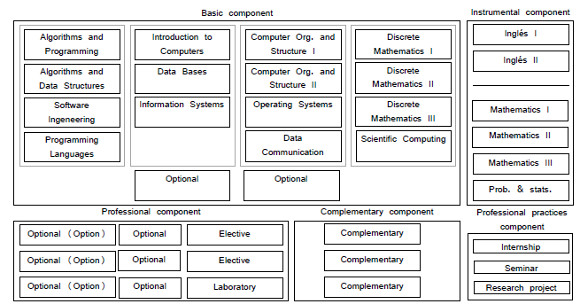
Figure 1 Distribution of the curriculum components [1]
Figure 1 shows the current Computer Science curriculum, which establishes the following aspects:
Courses of the basic and instrumental components in the first two years are compulsory as well as courses of the professional practice components—Internship, Seminar and Undergraduate Research project.
Courses of the professional component are either elective or optional. The student can take these courses after the fifth semester.
Complementary courses are elective, and the student, enrolled in the third semester or up, must pass at least three of them.
The Laboratory is a compulsory course designed to provide the student with the practical skills. The student must select one among the set of Laboratory courses offered.
The Internship is compulsory and is aimed to provide the students with the professional skills and interpersonal relationships in professional settings.
In 2010, during an academic staff meeting, the professors decided to review the graduate profile and they appointed a Committee to do that. After several meetings and a detailed revision of some documents, such as the proposal of the ACM and IEEE Computer Society for computing curricula [2], the Committee defined four graduate profiles: Computer Science, Software Engineering, Information and Communication Technologies and Information Systems [3]. The proposal was presented to the Department a year later [3].
3. Methodology
The study of the current Computer Science curriculum not only included an analysis of its structure, in terms of the relationship between courses, but also considered the perception that professors and students have of the career, as well as, the strengths and weaknesses of the graduates according to the opinion of the companies and institutions that hire them. We used several tools, such as interviews, surveys, brainstorming, and meetings, in order to recollect important data and obtain information about the current situation of the curriculum. We describe how we use these tools in our research as follows:
Interviews and questionnaires to the leaders of the eleven (11) Professional Options offered by the Department: the goal of the activity was to collect opinion, suggestions, and comments about the current curriculum.
Student survey: the aim of the survey was to know the reasons why the students work before they complete their university studies and the consequences of this behavior in their academic performance.
Statistical analysis of the student performance: the objective of the analysis was to determine the student academic performance in the first five semesters.
Brainstorming sessions: we conducted two brainstorm sessions. In each session, fifteen (15) professors and an external curriculum design expert participated. The goal of this activity was to know what professors propose to improve the graduate skills.
Meeting with representatives of companies and government institutions: the aim of the meeting was to determine the strengths and weaknesses of the Computer Science graduates, and the job skills and competencies required for the graduates.
Professor survey: the objective of the survey was to know the opinion of the professors about the strengths and weaknesses of the current curriculum and the aspects that should be reviewed.
Graduate survey: the aim of the survey was to know the opinion of the Computer Science graduates at the UCV about the curriculum and how the School of Computer Science could improve it.
4 Results
We present the results of the study in the following sections.
4.1 Opinion of the Profesional Option Coordinators
During the interviews, each of the eleven (11) Coordinators of the Professional Options expressed his opinion about the Computer Science curriculum. Table 2 shows the comments and suggestions by professional options.
The coordinators also commented about the factors which may affect the academic performance of the students:
The students do not get the programming skills expected for the degree.
The students communicate—oral and written—poorly.
The Department should increase the number of elective courses.
The Department should update the program of the following courses: Mathematic I, Mathematic II and Mathematic II in order to guarantee that the students get the mathematical skills required in more advanced courses.
Eleven (11) professional options are too many.
The Department should review the Computer Science curriculum taking into account the student performance and graduate profile.
Many students complete the compulsory courses but they do not have the expected skills.
Some professors should review the teaching strategies in order to adapt them to the trends in teaching computing.
The Department should review the program of some courses in order to include some topics related to professional ethic and social responsibility.
The average performance of students working is low because they usually do not go regularly to class and do not finish the assignments.
The Department should review prerequisites and program of several basic courses and the pathways of those courses.
Table 2 Opinion of the Coordinators of the Professional Options
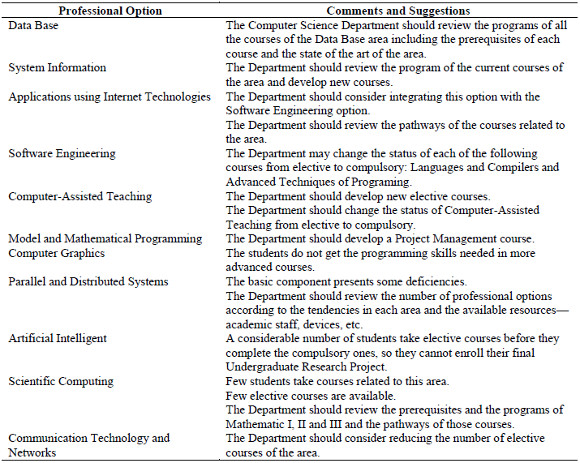
4.2 Strengths and Weaknesses of the Curriculum (Opinion of the Professional Option Coordinators)
Six Professional Option Coordinators answered the survey (see Methodology section). Figure 2 shows the curriculum strengths according to the coordinators.
The results shows that 33.33% of the coordinators expressed that the curriculum is flexible, since each student can follow different pathways of courses according the professional option he wants to complete. A 66.67% of coordinators considered that the students obtain the formation required for advanced professional courses.
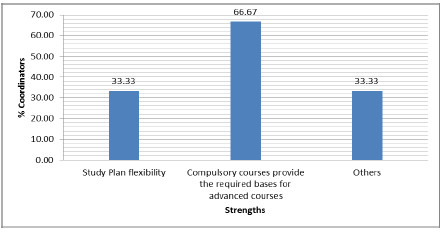
Figure 2 Strengths of the currculum acoording to the opinion of the Professional Option Coordinators.
Figure 3 shows that 16.67% of the coordinators considered that the Department should review the prerequisites of the courses, in particular courses such as Discrete Mathematic III, Probability and Statistical and Scientific Computing. Half of the coordinators commented about the pathways or programs of the courses, while 66.67% remarked about some aspects of the professional options: elective courses offered, number of elective courses proposed by the option and number of Undergraduate Research Projects offered.
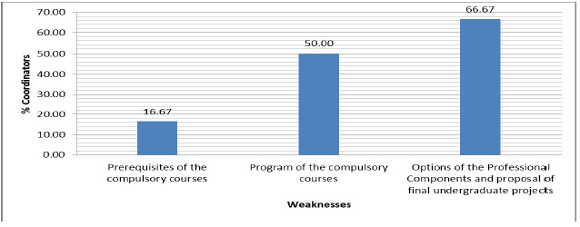
Figure 3 Weaknesses of the curriculum acoording to the opinion of the Professional Option Coordinators.
Figure 4 shows the aspects of the curriculum that need to be reviewed according to the coordinators. Consistent with the results presented in Figure 2, 16.67% of the coordinators considered that the Department should review the prerequisites of the compulsory courses. Half of the coordinators commented about the compulsory courses: new courses should be included in the curriculum, the pathways of the courses should be updated and the program of some courses should be reviewed. 33.33% of the coordinators considered that the programming skills of the students are insufficient. Another 33.33% of coordinators indicated the need to assess the verbal and written communication skills of the students. 16.67% of the coordinators expressed that Department should review the elective courses in order to update some courses and to develop new ones.
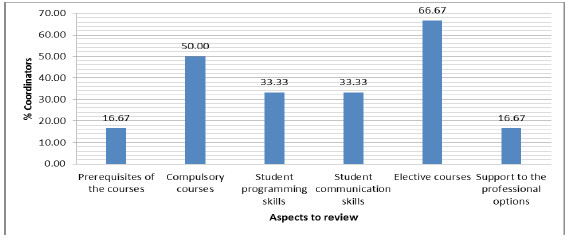
Figure 4 Aspects of the curriculum to be reviewed.
4.3 Opinion of the Professors
Thirteen (13) professors—over a total of 93 professors—answered the survey and gave their opinion about the curriculum (see Figure 5). These professors have taught 46 courses. They considered that some aspects of the compulsory and instrumental courses should be reviewed: pathways of the 17.39% of the courses, programs of 34.78% of the courses and prerequisites of 34.78 % of the courses.
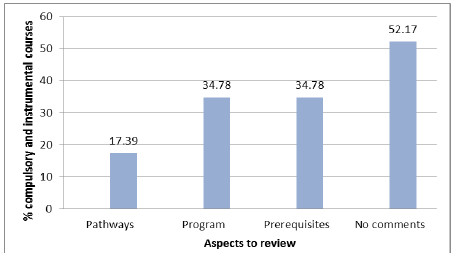
Figure 5 Aspects of the curriculum to be reviewed.
The professors also commented about the strengths and weaknesses of the students. They are summarized in Table 3.
4.4 Strengths and Weaknesses of the Computer Science Graduates Acoording to Organzations and Companies
Table 4 shows the strengths and weaknesses of the Computer Science Graduates according to the opinion of 4 company representatives and 3 public organization representatives.
Table 3 Strengths and weaknesses of the students according to the professors
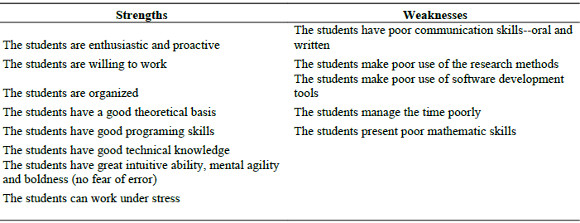
4.5 Student Performance
We analyzed the academic performance of the students enrolled between the years 2003 and 2008 (six years). Examining the performance of the students, starting from the first semester they enrolled in the course up to twenty semesters later. Although, we generated several graphs which show the student performance during these years [4], we only include some graphs which are representative for the paper.
Figure 6 and Figure 7 show the number of students who enrolled and passed the first semester courses: Mathematics I, Algorithm and Programing I, Introduction to Informatics and Discrete Mathematics I. We can note that of 634 students who enrolled in Mathematics I, 217 passed the course (i.e. 34%). Of 417 students who failed, 292 students enrolled in Mathematic I again; this shows that a significant number of students desert. In the second semester, 81 students passed Mathematics I which means that the percentage of students who passed the course decreased to 28%. In the third semester, of the 211 students who had not pass the course yet, 105 enrolled in the course and 23 passed it. We can conclude that the students fail to enroll in the course or drop out, so we can note that 27 students of the 634 still enrolled in Mathematics I in the fifth semester.
Table 4 Strengths and weaknesses of the students according to companies and public organizations
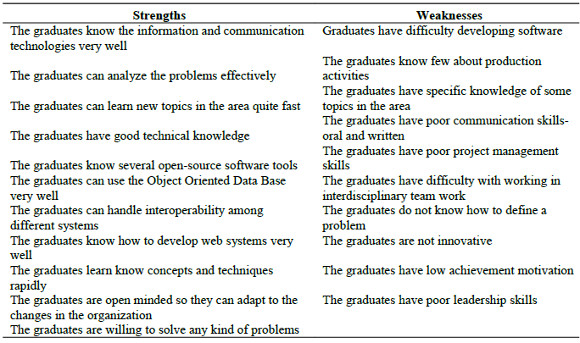
Six hundred ninety six (695) students enrolled in Algorithms and Programming I for the first time and 222 of those approved (i.e. 32%); this shows a similar behavior to Mathematics I. However, in the second semester, of the 474 remaining students, only 340 the re-enrolled in the course, and 108 students (32%) passed. Another 23 students passed Algorithms and Programming I in the third semester. Even in the fourth semester, 27 students enrolled in the course and 11 of them approved. We can also see a decrease in the percentage of students who re-enrolled in the course, which could be associated with student desertion. Some students continued enrolling in this course after he fifth semester.
Similarly to the other two courses, a high percentage of students who failed Discrete Mathematics I did not re-enroll in the course in the next semester—Figure 7 shows about a 50% of student desertion. We can also note that from the fourth semester and up, the student pass rate is less than 33%.
Unlike the other courses, the student performance in Introduction to Informatics is much better. Of 695 students, 420 (60%) passed the course in their first semester. More than half of the remaining students did not enroll in the course in the second semester—student desertion. Fifty four (54) of those who re-enrolled in the course, 130 students passed. In the following semesters, some students still did not enroll in the course and the percentage of students who passed the course decreased.
In the second and third semesters, the trends of student desertion and dropping out are similar to the previous semester, so we omit the statistics (see [4]). The study in [4] show that 40% of the students who passed Introduction to Informatics—as shown above—dropped out.
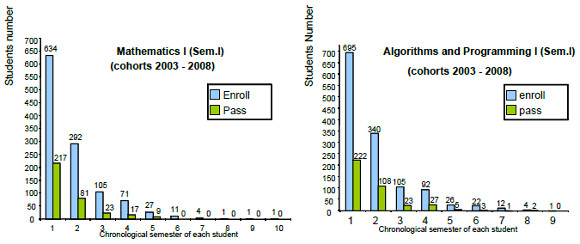
Figure 6 Number of students which enrolled and passed Mathemathics I (left) and Algorithms and Programming I (right) during their first semester.
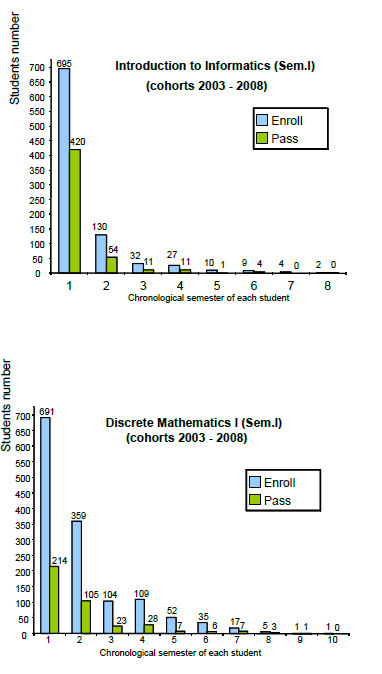
Figure 7 Number of students which enrolled and passed Introduction to Informatics (left) and Discrete Mathematics I (right) during their first semester.
Figure 8 and Figure 9 show the number of students who passed the courses of the fourth semester: Discrete Mathematics III, Probability and Statistics, Data Base and Operating Systems. In this semester, we can observe that the students did not follow the pathways of the courses; many of them enrolled Discrete Mathematics III in the third semester and enrolled in Probability and Statically in the sixth semester or later. Thus of the 56 students who enrolled in Discrete Mathematics III in semester three, 44 passed it (79%). Of the 102 students, enrolled in the fourth semester, 59 passed it (57%). As in other courses, the pass percentage decreased in the following semesters. In the tenth semester, some students still enrolled in Discrete Mathematics III.
In Figure 8, we can see that of 102 students who enrolled in Operating Systems, 55 passed the course (i.e. 53%). In the following semester, 78 students enrolled the course and 47 students passed it (60%). In the following semesters the percentage of students who passed decreased, less than 50%. After 15 semesters, some students still enrolled in Operating Systems.
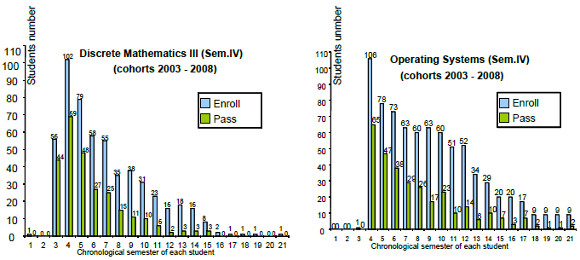
Figure 8 Number of students which enrolled and passed Discrete Mathematics III (left) and Operating Systems (right) during their fourth semester.
The pass rate in Probability and Statistics is the lowest, even for those students who enrolled in the fourth semester courses for first time. In the fourth semester, 71 students enrolled this course and 18 (25%) passed, while only 26% of the 50 students enrolled passed it in the fifth semester. In the sixth semester, we can see that 86 students enrolled in the course—the higher number of students enrolled—and 39 of them passed. The pass rate in each of the following semesters—sixth to twenty first—is low (it can drop to 9% in some semesters). In another analysis [4], we found that 38% of the students dropped out, while in other courses the drop-out rate is about 20%.
The students perform better in Data Base course.
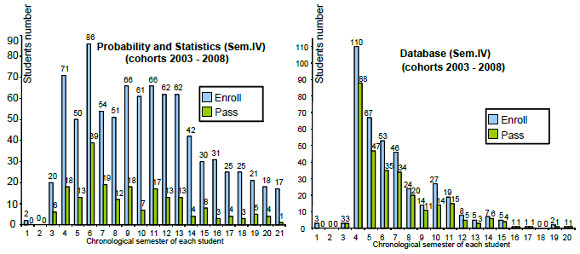
Figure 9 Number of students which enrolled and passed Probability and Statistics (left) and Database (right) during their fourth semester.
4.6 Relationship between Work and Study
Sixty five (65) students—19 to 28 year old--answered the survey to students who worked or have worked sometime during their Computer Science studies. Most of them had worked before enrolled in the fourth semester courses, some of them had even worked before enrolled in first semester courses. The results of the survey show the following:
More than 75% of the students worked or had worked in computing. The students who did not work in computing or any related job reported that they need to work to support their families.
Fifty seven students (57) dropped out one or more courses (23% of them dropped out all the courses and 24% students failed or withdrew at least one course).
The students work for several reasons: need for money, getting work experience and taking the chance.
A 70% of the students who answered the questionnaire were working at the moment they were consulted.
4.7 Opinion of the Computer Science Graduates
Two hundred and ten (210) graduates answered the survey—105 people completed their studies after the year 2003, so they followed the current Computer Science program. 71% of the graduates worked before they completed their studies, and currently 30% of the graduates are working out of the country. Figure 5 shows the opinion of the graduates about some aspects of the curriculum and the preparation obtained during their studies: terrible, poor, adequate, good and excellent. We reviewed the following aspects: (a) Professional ethics, (b) Social responsibility, (c) Oral communication, (d) Written communication, (e ) Elaboration of reports and documents, (f) Leadership and teamwork, (g) Theoretical preparation, (h) Practical training, (i) Professional preparation, (j) Computer science fundamentals, (k) Training in software development methodologies, (l) Networking and communication management, (m) System management and communication technologies, and (n) Analysis and problem solving techniques.
Table 5 Opinion of the graduates about some aspects of the curriculum (before 2003/after 2003)*
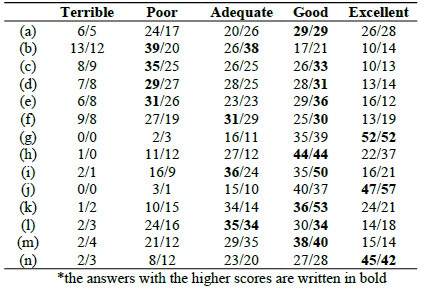
In overall, the number of good responses given by the graduates after 2003 is 66 more than those given by the other graduates, while the number of excellent responses is 39 more than the others. Thus, the results show that the graduates after 2003 are more satisfied with the formation obtained during their studies than the graduates before this year.
Most of the graduates after 2003 evaluated the aspects g, h, i, j, k, n between good and excellent, moreover the sum of good and excellent responses is twice more the sum of the others. The aspects (j) computer science fundamentals and (g) theoretical preparation obtained the greatest number of positive answers—excellent or good. The results also show that aspects such as (b) social responsibility, (d) written communication and (c) oral communication need to be improved.
Table 6 shows the perception of graduates in terms of the number of courses or activities in the current curriculum: insufficient, adequate, excessive or unbalanced. We considered the following courses/activities: (a) Basic courses, (b) Professional courses, (c) Practical activities, (d) Theoretical activities, (e) Complementary courses.
Table 6 Opinion of the graduates about the number of courses/activities included in the curriculum

According to the graduates, the number of basic courses and theoretical activities are acceptable. Most graduates indicated that professional courses and practical activities are insufficient. Almost haft of the graduates think the complementary courses are adequate.
Figure 10 shows distribution of the graduates in the following computing areas: (a) Information systems management, (b) IT management, (c) Web application development, (d) Mobile application development, (e) Network management, (f) Network security, (g) Technological innovation, (h) Computer science research, and (i) Other. We can note that 57 % of the graduates work developing Web applications (19%), Information Systems management (14%), IT management (14%), and Desktop applications development (10%). The information shown in the figure is important in order to define the skills and competencies for a graduate.
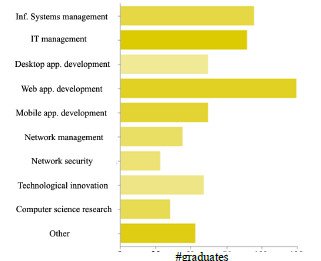
Figure 10 Distribution of graduates in some computing areas.
We also measured the opinion of the graduates about the knowledge obtained during their studies in the School of Computer Science. The results are the following:
Sufficient (62%).
Slightly deficient, needing some professional extension courses (34%).
Deficient, requiring extensive training through professional development courses (3%).
Deficient, needing to continue postgraduate studies (0%).
Highly deficient (0%).
We can see that almost two thirds of graduates answered that knowledge is sufficient, while 34% answered that it is slightly deficient and they needed to take some professional development courses.
4.8 A Proposal to Update the Curriculum
Figure 11 to Figure 13 shows the results of the two brainstorming sessions conducted with professors. From these meetings we detected four (4) aspects to enhance the curriculum: (a) To develop individual skills (Figure 11), (b) To generate skills to conduct researches (Figure 12-left), (c) To increase expertise in solving problems (Figure 12-right), and (d) To develop skills for project management (Figure 13).

Figure 12 Research skills (left) and Problem solving skills (right)

Figure 13 Project managment skills.
Professors believe that the students should develop ethical values, writing skills, and environmental awareness, among others. The application of different methodologies in software constructions is an important aspect too. They also said (see Figure 12-right) that the students should acquire the knowledge to solve problems and be able to transfer this knowledge. Leadership and group-working skills were also mentioned as important competencies (see Figure 13).
Figure 14 includes general competencies that should be considered when redesigning a new curriculum. After analyzing these diagrams, some priority areas were detected, such as: legislation—laws, rules and regulations related with information and communication technologies, methods and techniques for research in Computer Sciences, reading and writing technical documents, technical knowledge in computing, scientific reasoning ability, professional ethic, responsibility and commitment, and social aspect of computing.
5. Conclusions
The School of Computer Science at the Central University of Venezuela has initiated the review, evaluation and modification of the Computer Science curriculum following the guidelines of the Institution for the design and update of the curricula. This paper shows the results of diagnosis of the career which included surveys to professors, students and graduates, meetings with professors and representatives of companies and public institutions, and an analysis of the student performance.
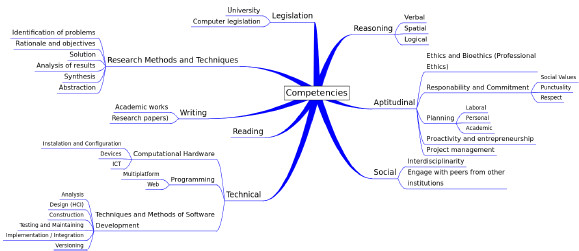
Figure 14 Competencies for a Computer Science student.
The results reveal that professors have a significant number of observations regarding the pathways, content and prerequisites of the courses of the basic and instrumental components. These results also show a low performance and high level of desertion of students of the four first semesters, which cover a large part of those components. However, we noted that professors have no major observations with respect to the courses of the professional component and their comments only include to update the program of some courses and to increase the number of elective courses offered in some areas. But, this perception of professors is far from the opinion given by the representatives of the companies and public organizations who noted a number of weaknesses of the graduates, many of which are related to graduate competencies.
In addition, the results show that many students do not follow the pathways of the courses correctly; this may delay the time to complete the degree. Thus we think that the flexibility of the current curriculum—recognized as one of its strengths—is not well understood by the students.
On the other hand, in recent years the professors are concerned about the negative consequences of work on student performance. The results of our study support the concern of the professors, since it shows that work have affected the performance of the student in more than half of the cases. A redesign of the curriculum and its implementation will need to take into account the reality that many of the students have or want to have a job before to complete their studies.
The diagnostic activities also included meetings with several professors to know their opinion about the skills of the graduate in Computer Science. The skills and competencies suggested by the professors should be taken into account in the redesign of the curriculum.
Finally, although we are satisfied with the results, we understand that there are aspects that have not been covered, such as the reasons for the high dropout of the students. Although there are some indications of what could be the causes, these have not been studied properly. A limitation of the study was the lack of budget to find more broad and detailed opinion of the private companies and public organizations.
After the study, we not only know the situation of the curriculum but also we have increased the awareness in curriculum change since we have involved many professors in our activities and noted great interest in the study. The research certainly is an invaluable input for the next phase, which should be the curriculum redesign, following the institutional guidelines defined by the UCV [5].
References
[1] Comisión Curricular de la Escuela de Computación de la UCV. Plan de Estudios de la Licenciatura en Computación. Universidad Central de Venezuela, Septiembre 2004.
[2] ACM. Curricula Recommendations. Consultado el 10 de enero de 2013, de: http://www.acm.org/education/curricula-recommendations.
[3] Rojas O, Villapol M.E., Silva A., Castillo Z., Parada J. y Correa E. Propuesta de Definición de Perfiles del Egresado. Documento de trabajo, Escuela de Computación, UCV, Marzo 2011.
[4] Comisión Curricular de la Escuela de Computación de la UCV. Informe sobre rendimiento estudiantil. Reporte CCC_2012_04, Escuela de Computacion, UCV, Diciembre 2012.
[5] Comisión Central de Currículo. Lineamientos Curriculares para Formular Diseños de Carreras o Rediseños Curriculares en la UCV. Universidad Central de Venezuela, 17 Mayo de 2006. Consultado el 1 de marzo de 2011, de: http://www.ucv.ve/uploads/media/LINEAMIENTOS_CURRICULARES_PARA_FORMULAR_DISE%C3%91OS_DE_CARRERAS_O_REDISE%C3%91OS_CURRICULARES.pdf.













